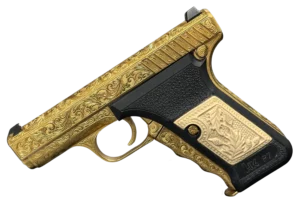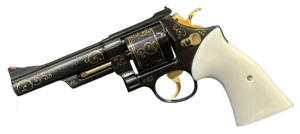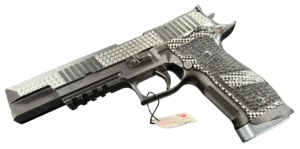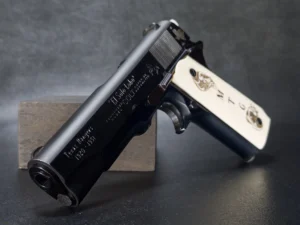Key Takeaways:
- Not all expensive guns are flashy, and not all flashy guns are junk: You’ve got high-end firearms that are pure performance machines, built to outshoot everything else on the line. Then you’ve got Gucci guns—customized, colorful, sometimes wild—but often built on solid, reliable platforms. Don’t judge by the paint job alone.
- Choosing between a precision-built gun and a designer piece isn’t about right or wrong—it’s about what matters to you: Are you into tight groupings and smooth triggers? Or do you want something that makes a statement every time you unholster it? Either way, you’re in good company. Guns can be tools, but they can also be art. Sometimes both.
- The real value of a firearm goes beyond price tags and brand names: At the end of the day (ugh—sorry, couldn’t resist), what makes a gun valuable is how it feels in your hand, how it performs when you need it, and how it fits into your world—whether that means the range, the safe, or a spot on your wall next to a custom Bowie knife and a bottle of bourbon.
Let’s be honest—most people don’t associate guns with style. Power, precision, maybe some rugged utility? Sure. But fashion? Not so much.
And yet… here we are.
There’s a strange and fascinating corner of the firearms world where craftsmanship meets couture, where utility gets dressed up in exotic metals and intricate engravings. It’s the space where high-end “performance-first” guns brush shoulders with their flashier cousins—designer firearms, the so-called “Gucci guns.”
If you’re deep in the gun world, you’ve probably already got strong opinions. But for the rest of us just peeking over the velvet rope, the question still hangs in the air:
What’s the real difference between a premium firearm and a Gucci one? And more importantly, does it matter?
Let’s dig in.
What Exactly Are We Talking About?
First, some quick definitions—because the lines blur, and let’s not pretend they don’t.
Expensive guns typically get that label because of what they do. Think Swiss-watch levels of precision, premium materials, and performance that hold up under scrutiny. They’re engineered, not accessorized.
Gucci guns, on the other hand, care just as much (if not more) about how they look. We’re talking laser-etched slides, wild Cerakote jobs, gold accents, snakeskin grips—maybe even a designer logo snuck in somewhere. They’re guns with an ego. And weirdly enough, they can shoot pretty well, too.
But here’s the thing—they don’t always overlap. A $7,000 competition pistol might look like a slab of steel to the untrained eye, while a neon-colored Glock might be more “flex” than function. It all depends on what you value.
When Price Meets Precision: The World of Expensive Guns
Let’s start with the old money crowd.
High-end firearms—your Nighthawk Customs, your Cabot Guns, your Korth revolvers—aren’t just about price tags. They’re about execution. Every curve, every mechanical tolerance, every trigger pull is tuned with care. And it shows.
These guns feel different. There’s no play in the slide. The weight is balanced. The recoil feels less like a kick and more like a whisper. Some are hand-fitted. Some are built in small batches, almost like they’re whispering, “You’re lucky to have me.”
So what drives the cost?
- Materials. We’re not talking polymer frames and stamped parts. Think billet stainless, Damascus steel, titanium, carbon fiber. Materials that last—and flex a bit of muscle in the looks department, too.
- Craftsmanship. Machines don’t crank these out on an assembly line. There’s usually a master gunsmith involved, checking tolerances and hand-polishing internals.
- Brand Legacy. A gun from a company with 150 years of precision behind it carries weight, and that heritage often pads the price.
- Performance. Whether it’s sub-MOA accuracy or competition-grade trigger systems, these guns are built to perform when it counts.
To be fair, there’s often a collector angle too. Some of these pieces are meant to be admired as much as they’re meant to be fired.
Enter the Gucci Gun
Now flip the coin.
Gucci guns don’t always come from legacy brands. Sometimes they’re built by niche shops, influencers, or boutique cerakoters with a flair for drama. You might recognize them from Instagram before you ever see one in a gun shop.
They’re loud. They’re proud. And yeah—sometimes they’re ridiculous. (Looking at you, gold-plated Desert Eagle with Louis Vuitton print.)
But not all Gucci guns are just for show.
Many are built off solid platforms—Glock 19s, SIG P320s, AR-15s—and then dressed to the nines. Underneath the style, they can still hold their own at the range.
What makes a Gucci gun?
- Customization. Custom stippling, aftermarket triggers, threaded barrels, slide cuts, optics-ready platforms—you name it.
- Design. These guns are designed to pop. Neon, camo, or color-matched to your sneakers—they’re made to be seen.
- Exclusivity. Limited runs, small-batch collaborations with fashion brands or artists. They’re rare, and that’s the point.
- Flex Factor. Let’s be real—some folks buy Gucci guns because they look good in photos. It’s part of the appeal.
It’s fashion-meets-function, and the ratio depends on the build. Some are range-ready. Some are safe queens.
So… Is One Better Than the Other?
That’s the wrong question. Or at least, it’s the wrong kind of question for this space.
It’s not about better—it’s about what matters to you.
Are you a purist who wants a match-grade 1911 that can shoot tighter than your coffee budget? Or are you the kind of person who wants your Glock to match your watch and EDC knife?
One’s not “right” and the other “wrong.” They’re just different expressions of the same obsession.
Still, it helps to look at the contrast more directly.
| Feature | Expensive Guns | Gucci Guns |
|---|---|---|
| Purpose | Performance, precision | Style, self-expression |
| Customization | Functional upgrades | Aesthetic + functional mods |
| Materials | Tool steel, exotic alloys | Can vary wildly (including cosmetic finishes) |
| Brand | Legacy manufacturers | Often boutique builders or collaborations |
| Market | Collectors, shooters | Trendsetters, social media enthusiasts |
| Resale Value | Often stable or rising | Often, boutique builders or collaborations |
Some Iconic Examples to Ground This Conversation
Let’s anchor all this with a few real-world examples—because abstract talk is fun, but it gets better with names.
On the Expensive Side:
- Korth Super Sport: A revolver so smooth it makes Swiss watches jealous. German engineering at its finest. Also about $5,000+.
- Cabot Guns “The Jones 1911”: Hand-crafted, mirror-polished, perfectly balanced. One-of-a-kind collector status.
- SIG P210: Originally Swiss-made, now with a modern twist. Clean lines, incredible accuracy, and the feel of real craftsmanship.
On the Gucci Side:
- Agency Arms Glock builds: Wild slide cuts, skeletonized barrels, custom triggers, sometimes dipped in designer patterns.
- Salient Arms International: High-end performance meets luxury finishes. Their shotguns and handguns blur the line between showpiece and workhorse.
- Taran Tactical custom jobs: If you’ve seen “John Wick,” you’ve seen a Taran gun. Part functional upgrade, part Hollywood glam.
And somewhere in the middle? You’ve got brands like Nighthawk, Atlas Gunworks, and Zev—hybrids that don’t really fit in one box or the other.
The “Is It Practical?” Question
Let’s talk utility.
A common jab at Gucci guns is that they’re impractical. Too pretty to shoot. Too flashy to carry. Too delicate to train with.
And sometimes… yeah, that’s fair.
A gun with a gold finish and custom inlays isn’t what you want to toss in the truck during a rainy weekend in the woods. But a Gucci-styled Glock with upgraded internals, a red-dot optic, and a compensated barrel? That can absolutely run.
The takeaway? It depends on the build. Some Gucci guns are built on solid bones. Others are more for show than go. You just need to know which is which before you drop $3,000 on one.
So, Which Should You Pick?
You knew this was coming: it depends.
But here’s how to think about it:
- If you’re the kind of shooter who obsesses over groupings, reliability under stress, and long-term performance, lean toward the expensive, purpose-built stuff.
- If you want your gun to turn heads at the range, or if you just want something that feels personal and expressive, Gucci’s calling your name.
Also, it doesn’t have to be one or the other.
You can absolutely have a meticulously tuned Wilson Combat in the safe… and a flashy, stippled Glock 43X in the nightstand. No one’s stopping you.
Final Thoughts: Guns, Like People, Can Be Both Beautiful and Capable
This whole Gucci vs. expensive gun conversation? It’s not really about the guns. Not entirely.
It’s about what you want out of the experience.
Some folks want performance. Others want flair. The lucky few? They want both—and they’re willing to pay for it.
Whether you’re buying a hand-fit 1911 that feels like poetry or a camo-dipped AR with a holographic sight and attitude, you’re still part of the same story. You’re chasing the feeling of something exceptional in your hands.
And at the end of the day—sorry, scratch that—when it’s all said and done, the real flex isn’t the price or the pattern.
It’s owning something that feels right every time you pick it up.
Frequently Asked Questions
Nope—despite the name, Gucci has nothing to do with it (at least, not yet). “Gucci gun” is just slang for any firearm that’s decked out with flashy finishes, custom parts, or wild colors. It’s more about style and self-expression than it is about the brand on the box. Think of it like calling a fancy sports car a “Lambo,” even if it’s not made in Italy.
Surprisingly? A lot of them can run just fine. Many Gucci guns are built on proven platforms, such as Glocks, SIGs, or ARs—they get dressed up with aftermarket triggers, optics, stippling, and Cerakote. That said, some lean a little too hard on the style side and sacrifice durability or practicality. You’ve gotta know what you’re buying.
Usually, it comes down to materials, craftsmanship, and performance. We’re talking precision-machined parts, hand-fitting, premium finishes, and often a brand legacy going back decades. These guns aren’t just pretty—they’re engineered to perform at the top of their game. Some are made in tiny batches, and some are borderline works of art.
Absolutely. There’s a lot of overlap these days. You’ll find boutique builders offering pistols that cost $5,000 or more, which are both jaw-droppingly accurate and visually outrageous. Gold barrels, Damascus slides, hand-engraved grips—it’s a thing. You’re not choosing one or the other; you’re choosing your flavor of luxury.
Ask yourself what matters more: performance or personality. If you plan to shoot frequently and want something built like a tank, lean toward a high-end, proven performer. If you’re more into custom looks, collecting, or want a cool range toy that turns heads, a Gucci-style build could be a fun starting point. Just don’t blow your whole budget on looks alone—make sure it shoots.












